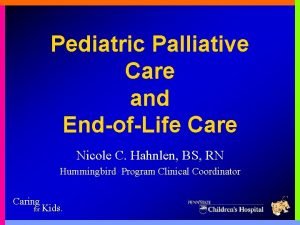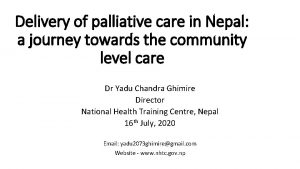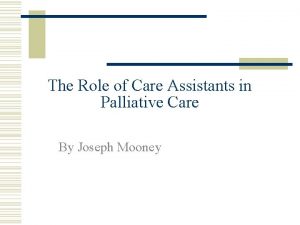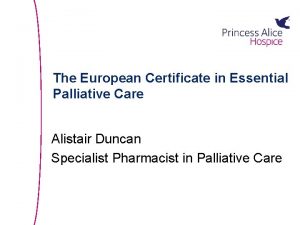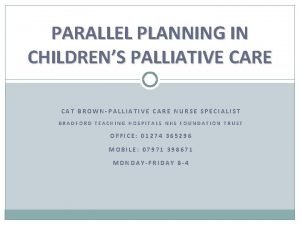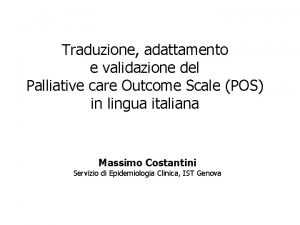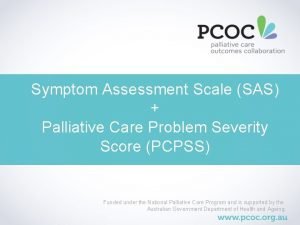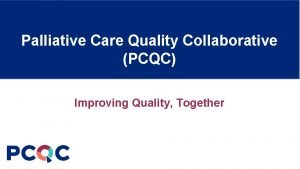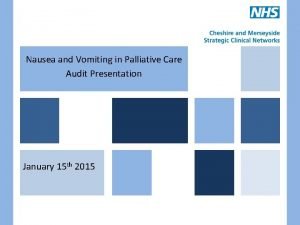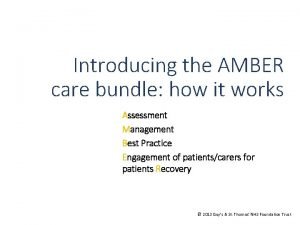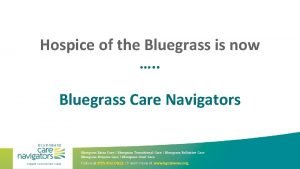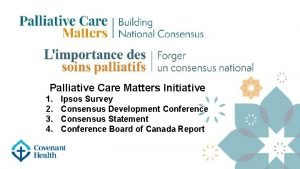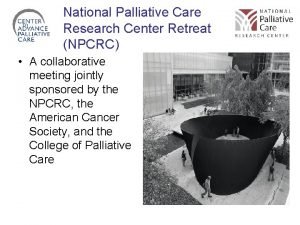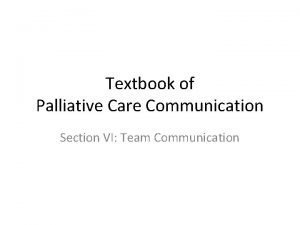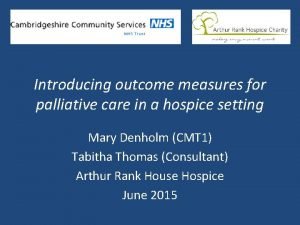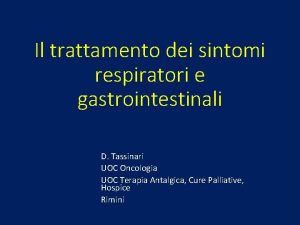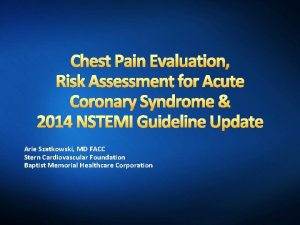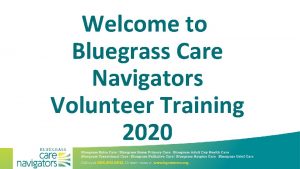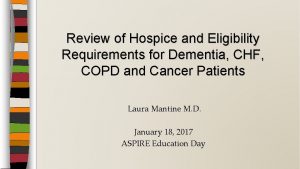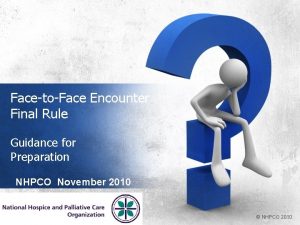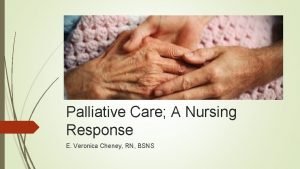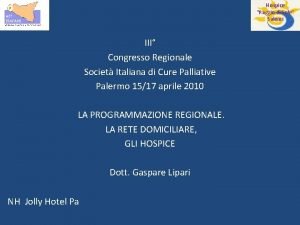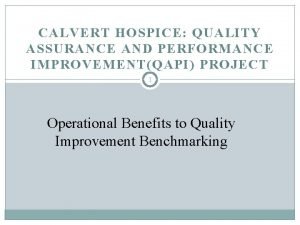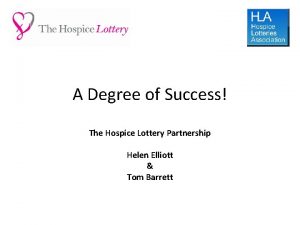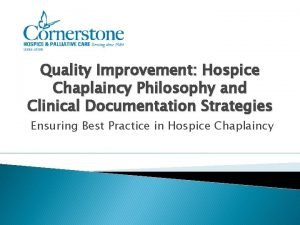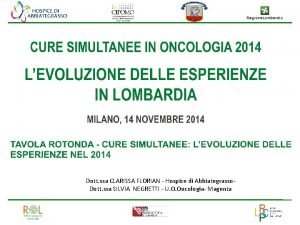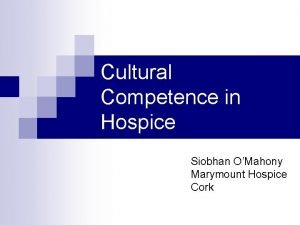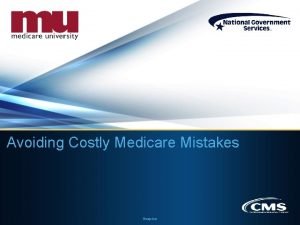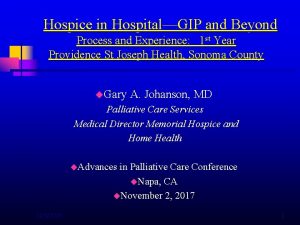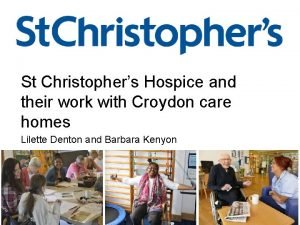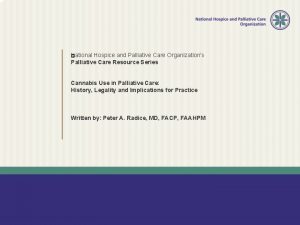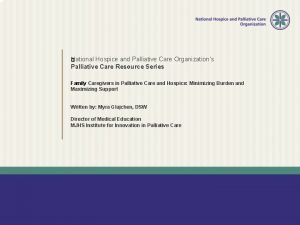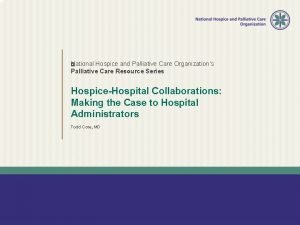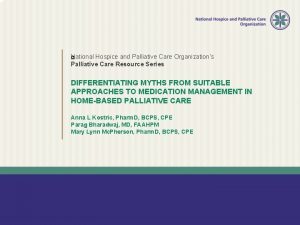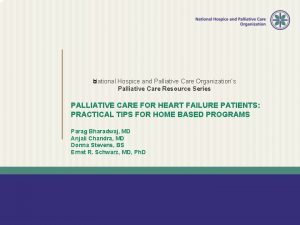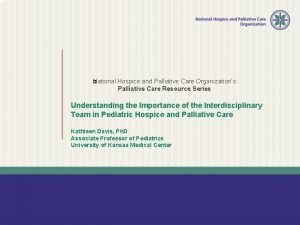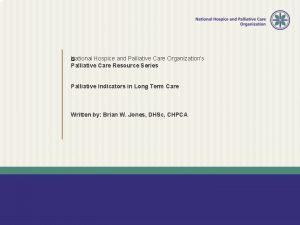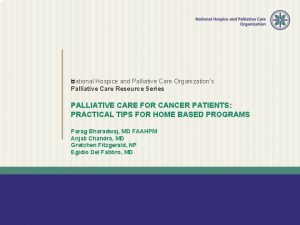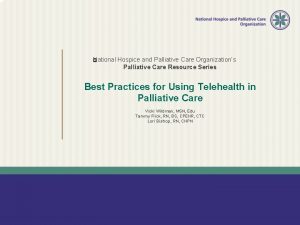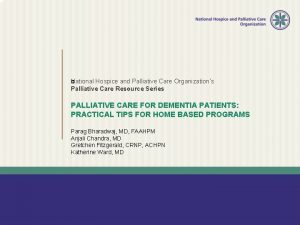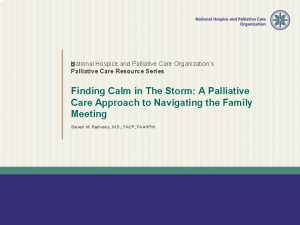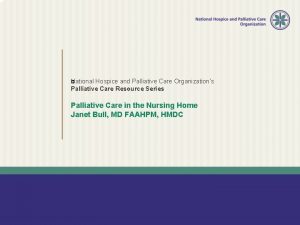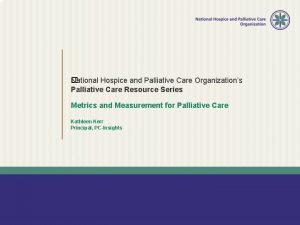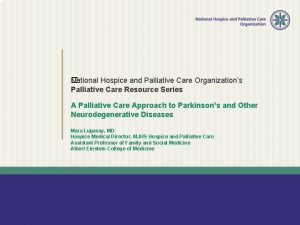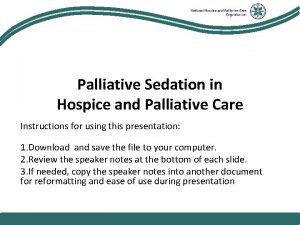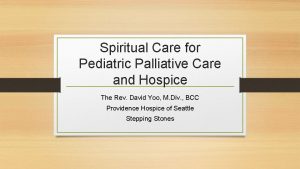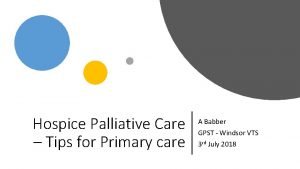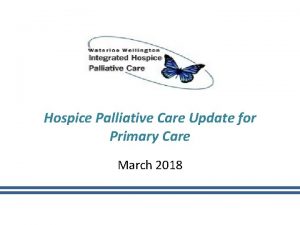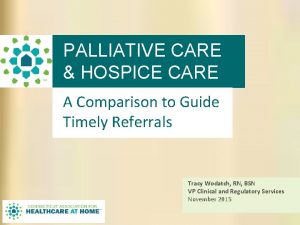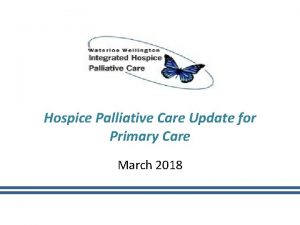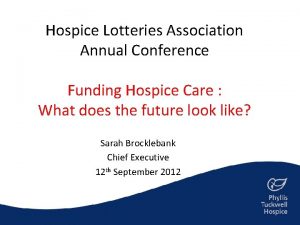The Time is Now Palliative Care Hospice Eric

































































- Slides: 65

The Time is Now: Palliative Care & Hospice Eric Bush MD, RPh, MBA Medical Director, Pain & Supportive Care Service Frederick Memorial Hospital Medical Director, Hospice of Frederick County Chairman, Ethics Committee, Frederick Memorial Hospital

Disclosure No financial interests, relationships to disclose.

Objectives Define Palliative Care Define Hospice Care Know criteria for appropriate Palliative Care Referral Know criteria for appropriate Hospice Care Referral Understand how to “break bad news” Know SPIKES as method to break bad news Understand physician role in goals of care


It’s Amazing What We Do & Don’t Prioritize

Physicians overestimate life expectancy by what percent? a) b) c) d) e) 10 50 70 90 Google

2010 US Cause of Death

What People Want: • To die at home • To be free from pain • To be in the company of loved ones • To retain control of the care we receive

The Contrast of Reality • Less than 25 percent of Americans die at home, although more than 70 percent say that is their wish • Dying is often unnecessarily painful and isolating • Only 20 to 30 percent of the population has completed an advance directive

Reasons for this Stark Reality Doctors aren’t aware of their patients’ wishes. A major 2007 study found that only 25% of physicians knew that their patients had advance directives on file. The end of life is often treated only as a medical moment

Frederick County Hospice utilization by FIHN ACO patients is half that of other ACOs FMH Hospice utilization is one-third the Medicare FFS national average Average Length of Stay for patients in Hospice of Frederick County is 35 days compared to national average of 67 days

The Local Stark Reality “What we have here is a failure to communicate…. ”-all apologies to Cool Hand Luke Culture that profoundly underutilizes Hospice services Pt/family often experience Hospice late if at all and do not derive maximal benefit from Hospice care


Differentiation Hospice Care -if the disease follows the expected course, the prognosis is six months or less (patients often referred late, NEJM NSCLC study) Supportive(Palliative) Care -symptom focused care throughout the disease spectrum/life span, can be delivered in conjunction with curative care

Palliative/Supportive Care Spectrum Studies have shown that incorporating palliative care with conventional medical treatment prolongs survival. Patients and their families both can benefit from an improved sense of well-being.

Who could benefit from Pain and Supportive Care Services? Anyone with advanced or chronic illness experiencing symptoms due to the illness itself or secondary symptoms caused as a result of treatments for the disease. This may include the following: Cancer Infectious disease Kidney/liver disease Heart disease Lung disease Neurological disease Advanced dementia Chronic pain

Criteria for Palliative Care Referrals No automatic referrals All referrals require physician consult Increased cultural awareness throughout the system Ongoing efforts for system wide trigger with respect to CHF patients and Stage 4 non-small cell lung cancer patients (only 28% eligible patients referred during 2014) Collaboration is key(pertinent specialist involvement early in hospital course)

High Quality Palliative & Hospice Care-2015 Citation of Honor & TJC Certification

Basic Concepts of Hospice & Supportive (Palliative Care)

Supportive Care Palliative Care given to improve the quality of life of patients who have a serious, chronic or life-threatening disease. The goal of palliative care is to prevent or treat as early as possible the symptoms of a disease, side effects caused by treatment of a disease, and psychological, social, and spiritual problems related to a disease or its treatment. In short, symptom management, regardless of where the patient is in the disease process utilizing a biopsychosocial approach

Nature of Pain/Quality of Life Nociceptive Somatic, Visceral, Myofascial Psychological State and Traits Loss of Work Neuropathic Pheripheral, central Pain Mechanisms Total Pain Psychological Influences Spirituality Social/Family Functioning Suffering Physical Disability Fear of Death Financial Concerns


Family/patient assessment Underlying philosophy of shared decisionmaking and respecting autonomy Beneficence, autonomy Advanced directives, living will

Diagnoses for Palliative Care Referral CHF-Stage D-NYHA 4 COPD/Pulmonary Diseases-End Stage Neuro-stroke, ALS, MS, dementia (FAST >7 A) Oncology-Stage 4 Disease

Dementia Hospice criteria ADEPT criteria (JAMA 2010) Goals of care, do not hospitalize orders for Nursing Home and Long Term Care Facility Patients


Diseases & corresponding poor prognostic indicators

(a) Survival post-admission to an inpatientpalliative unit, all diagnoses (Virik 2002). (b) Days until inpatient death following admission to an acute hospice unit, diagnoses not specified (Anderson 1996). (c) Survival post admission to an inpatient palliative unit, cancer patients only


Case 1 51 year old Female with Stage 4 NSCLC Supportive son Chemo/Radiation Convinced that Hospice=death Lived approximately several days after completion of palliative Chemo/Radiation Time from diagnosis to death approx. 18 mo

Case 2 50 yo Female with Stage 4 NSCLC Supportive spouse, former military PTSD Chemo/RT, brain mets, targeted tx Multimodal supportive care Good quality of life including trips to Florida with family Time from diagnosis to death approx 30 mo

Case 3 67 yo Male with NY Heart Association Class 4 Heart Failure, Amyloidosis, multiple hospitalization Poor PPS(30), seen initially for Supportive Care, did not want to return to hospital PT/OT targeted pharmacologic interventions Several months good quality of life Transition to home hospice and died at home surrounded by family

Now that we know who can benefit from Palliative Care and Hospice, how do we have the conversation?

A profound thought…. . “ The bad news about breaking bad news is that bad news is bad news. ”

Definition Bad news is any news that seriously and adversely affects the patient’s view of his or her future.

Separate MESSAGE from MESSENGER Even though the message is bad, the messenger can be seen as part of the support system. Attitude is extremely important.

Myth- breaking bad news is an innate skill Physicians who are good at discussing bad news with their patients usually report that breaking bad news is a skill that they have worked hard to learn. Furthermore, studies of physician education demonstrate that communication skills can be learned, and have effects that persist long after the training is finished.

SPIKES method S P I K E Getting the SETTING right What the patient PERCEIVES An INVITATION to share the news Giving the KNOWLEDGE EMPATHISING & EXPLORING the patient’s emotions and S STRATEGY and SUMMARY

S = SETTING Privacy family members Eye contact Body language and positioning Psychotherapy neutral position

Getting Started The physical setting ought to be private, with both physician and patient comfortably seated. You should ask the patient who else ought to be present, and let the patient decide It is helpful to start with a question like, "How are you feeling right now? "

Starting off BEFORE YOU TELL, ASK

P-Perception Different ways of asking Assess vocabulary and comprehension Note denial Listening Skills: -silence -repetition -“listening mode” -touch (as appropriate) -avoid office interruptions

Find out patient perception Ask a question such as, "What have you already been told about your illness? " Begin to understand what the patient has already been told ("I have lung cancer, and I need surgery") How much does the patient understand about what's been said ("the doctor said something about a spot on my chest x-ray") Patient level of technical sophistication ("I've got a T 2 N 0 adenocarcinoma") Patient emotional state ("I've been so worried I might have cancer that I haven't slept for a week").

I-INVITATION by the Patient to Share the Information Different ways of asking Level of information to provide Aim to get a clear invitation-often indicated by patient query such as “what else should I know? ”

K- Giving the KNOWLEDGE and Medical Facts Aligning starting at a point compatible with the patient’s current comprehension and terminology Small chunks of information, check reception Avoid “medspeak” Adjust pace according to patient’s response

Sharing the information Decide on the agenda before you sit down with the patient, so that you have the relevant information at hand. The topics to consider in planning an agenda are: diagnosis, treatment, prognosis, and support or coping. However, an appropriate agenda will usually focus on one or two topics.

Info sharing pointers Give the information in small pieces, stop between each section to ask the patient if he or she understands ("I'm going to stop for a minute to see if you have questions"). Long lectures are overwhelming and confusing. Remember to translate medical terms into English, and don't try to teach pathophysiology, avoid “medicalese”.

E-Acknowledging EMOTIONS The “Empathic Response” Identify the emotion (theirs or yours) Identify the source of the emotion Respond in a way that shows you have made that connection You don’t have to agree with the viewpoint Avoid downplaying severity of situation You don’t have to feel the emotion yourself

Responding to patient feelings If you don't understand the patient's reaction, you will leave a lot of unfinished business, and you will miss an opportunity to be a caring physician. Learning to identify and acknowledge a patient's reaction is something that definitely improves with experience.

S - STRATEGY & SUMMARY Develop plan collaboratively Summarize main areas Any questions for now? Clear plan for next steps

Planning and follow-through Synthesize the patient's concerns and the medical issues into a concrete plan that can be carried out in the patient's system of health care. Outline a step-by-step plan, explain it to the patient, and contract about the next step. Be explicit about your next contact with the patient ("I'll see you in clinic in 2 weeks"). Give the patient a phone number or a way to contact the relevant medical caregiver if something arises before the next planned contact.

What if the patient starts to cry while I am talking? In general, it is better simply to wait for the person to stop crying. If it seems appropriate, you can acknowledge it ("Let's just take a break now until you're ready to start again") but do not assume you know the reason for the tears (you may want to explore the reasons now or later). .

The best laid plans of mice and men often go astray…… I had a long talk with the patient yesterday, and today the nurse took me aside to say that the patient doesn't understand what's going on! What's the problem? Sometimes patients ask the same question of different caregivers, sometimes they just didn't remember it all, and sometimes they need to go over something more than once because of their emotional distress, the technical nature of the medical interventions involved, or their concerns were not recognized and addressed.

Its not you its me, well maybe it really is you…. . I just saw another caregiver tell something to my patient in a really insensitive way. What should I do? First, examine what happened and ask yourself why the encounter went badly. If you see the patient later, you might consider acknowledging it to the patient in a way that doesn't slander the insensitive caregiver ("I thought you looked upset when we were talking earlier and I just thought I should follow up on that--was something bothering you? ")

S-P-I-K-E-S Method Easy to remember steps Physicians can separate themselves from the “bad news”

Perspective Breaking bad news is never easy or pleasant: but at least having some plan or approach increases the professional’s feeling of confidence and that is often perceived as increased competence

Case-sometimes you have to take what the defense gives you 74 year old Female, non-small cell lung cancer Stage IV at diagnosis Never smoked, drank, etc Scapular and abdominal pain Consulted for “pain mgmt” Family wants hospice, pt angry, not agreeable

Steps Day 1 -address pain Day 2 -address code status (more important than macro goals discussion) Day 3 -pt agreeable to hospice Day 6 -peaceful death at Kline House

Summary Performance status important trigger for appropriate supportive/pall care/hospice referrals Please include pertinent specialist physician input early in hospital course We are there to support you and our patients/families throughout the spectrum of care Effort for true patient centered care must be united to be successful, resulting in better outcomes


Why Now? It’s the right thing to do You and your patient will benefit (no one is taking your patients) Your patients/families will thank you You will be an even better doctor than you already are (hard to believe) You will get more hugs (trust me it helps) You didn’t go into medicine for you “Cure sometimes, treat often, comfort always. " Hippocrates

Medicine in a Minute Ask for Advanced Directives and Review (PQRS) “Would you be surprised if this patient died within the next year? ” –Validated positive predictor for Cancer patients, likely true for Non. Cancer Patients Ask patients, ”What is your understanding of your medical problems at this time? ” Ok to show you care, appropriately Your patients and families will appreciate you more


Final Thought Do not undertake anything beyond your capacity and at the same time do not harbor the wish to do less than you can. One who takes up tasks beyond his powers is proud and attached. On the other hand, one who has done less than he can is a thief— -- Mohandas Gandhi

Video Links https: //www. youtube. com/watch? v=ja. B 9 M 8 B_ https: //www. youtube. com/watch? v=ja. B 9 M 8 Tuw&feature=em-share_video_user B_Tuw&feature=em-share_video_user https: //www. youtube. com/watch? v=LA 5 Yt. Z m 0 Pkk&feature=em-share_video_user
 Palliative care versus hospice care
Palliative care versus hospice care Franciscan palliative care
Franciscan palliative care Esasr
Esasr Karnofsky scale
Karnofsky scale Tarek mahdi md
Tarek mahdi md Principles of palliative care
Principles of palliative care Palliative care in nepal
Palliative care in nepal Palliative care assistant
Palliative care assistant European certificate in palliative care
European certificate in palliative care Parallel planning palliative care
Parallel planning palliative care Hospice care traduzione
Hospice care traduzione Problem severity scale
Problem severity scale Pcqc registry
Pcqc registry Nausea and vomiting in palliative care powerpoint
Nausea and vomiting in palliative care powerpoint Just in case bag palliative care
Just in case bag palliative care Amber care meaning
Amber care meaning Goscote palliative care centre
Goscote palliative care centre Barry laird
Barry laird Bluegrass hospice
Bluegrass hospice Calvary palliative care kogarah
Calvary palliative care kogarah Anorexia, nausea and vomiting
Anorexia, nausea and vomiting Palliative care matters
Palliative care matters Dr hong-phuc tran
Dr hong-phuc tran Goc palliative care
Goc palliative care Npcrc
Npcrc Driver diagram palliative care
Driver diagram palliative care Anergia definition
Anergia definition Textbook of palliative care communication
Textbook of palliative care communication Oacc palliative care
Oacc palliative care Ethical issues in palliative care
Ethical issues in palliative care Primary secondary tertiary medical care
Primary secondary tertiary medical care Now i see it now you don't
Now i see it now you don't Palliative performance scale
Palliative performance scale Criterios de terminalidad
Criterios de terminalidad Adjuvant neoadjuvant palliative
Adjuvant neoadjuvant palliative Nucot cos'è
Nucot cos'è Palliative prognostic index
Palliative prognostic index Provocative/palliative
Provocative/palliative Palliative fase
Palliative fase Palliative xrt definition
Palliative xrt definition Example of elapsed time
Example of elapsed time Pps scale
Pps scale Hospice forum
Hospice forum Hospice lcd dementia
Hospice lcd dementia Hospice laveno
Hospice laveno Hospice face to face template
Hospice face to face template Pps scale hospice
Pps scale hospice Chapter 23 dying death and hospice
Chapter 23 dying death and hospice Hospice secretions medication
Hospice secretions medication Hospice salemi
Hospice salemi Hospice quality assurance
Hospice quality assurance Sobell house lottery
Sobell house lottery Hospice chaplain documentation examples
Hospice chaplain documentation examples Hospice marketing strategies
Hospice marketing strategies Hospice abbiategrasso
Hospice abbiategrasso Marymount hospice
Marymount hospice Macy catheter medication administration
Macy catheter medication administration Understanding hospice
Understanding hospice Casi hospice général
Casi hospice général Reason code 39929
Reason code 39929 +hospice +local
+hospice +local Hospice codigoro
Hospice codigoro The hospice
The hospice Nhpco gip tip sheet
Nhpco gip tip sheet St christophers hospice croydon
St christophers hospice croydon Sentara leigh therapy center
Sentara leigh therapy center





